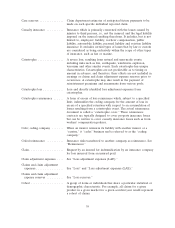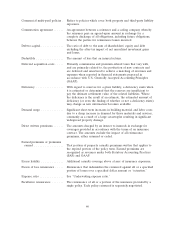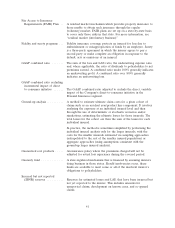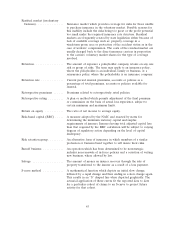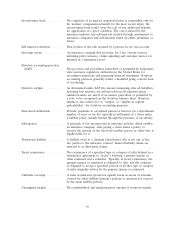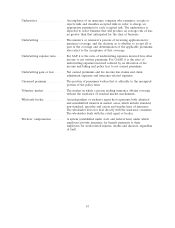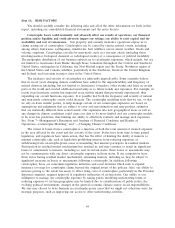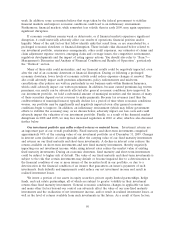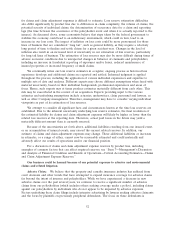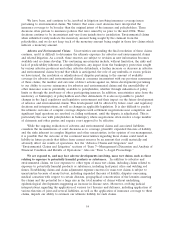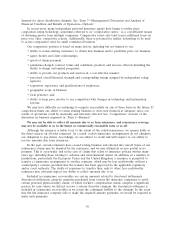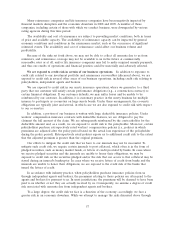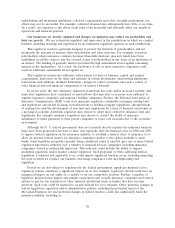Travelers 2009 Annual Report Download - page 61
Download and view the complete annual report
Please find page 61 of the 2009 Travelers annual report below. You can navigate through the pages in the report by either clicking on the pages listed below, or by using the keyword search tool below to find specific information within the annual report.There are also risks that impact the estimation of ultimate costs for catastrophes. For example, the
estimation of reserves related to hurricanes can be affected by the inability to access portions of the
impacted areas, the complexity of factors contributing to the losses, the legal and regulatory
uncertainties and the nature of the information available to establish the reserves. Complex factors
include, but are not limited to: determining whether damage was caused by flooding versus wind;
evaluating general liability and pollution exposures; estimating additional living expenses; the impact of
demand surge; infrastructure disruption; fraud; the effect of mold damage; business interruption costs;
and reinsurance collectability. The timing of a catastrophe’s occurrence, such as at or near the end of a
reporting period, can also affect the information available to us in estimating reserves for that reporting
period. The estimates related to catastrophes are adjusted as actual claims emerge and additional
information becomes available.
Exposure to catastrophe losses or actual losses following a catastrophe could adversely affect our
financial strength and claims-paying ratings and could impair our ability to raise capital on acceptable
terms or at all. Also, as a result of our exposure to catastrophe losses or actual losses following a
catastrophe, rating agencies may further increase capital requirements, which may require us to raise
capital to maintain our ratings or adversely affect our ratings. A ratings downgrade could hurt our
ability to compete effectively or attract new business. In addition, catastrophic events could cause us to
exhaust our available reinsurance limits and could adversely impact the cost and availability of
reinsurance. Such events can also impact the credit of our reinsurers. For a discussion of our
catastrophe reinsurance coverage, see ‘‘Item 1—Business—Reinsurance—Catastrophe Reinsurance.’’
Catastrophic events could also adversely impact the credit of the issuers of securities, such as states or
municipalities, in whom we have invested.
Although the Terrorism Risk Insurance Program Reauthorization Act of 2007 (the ‘‘Act’’) provides
benefits in the event of certain acts of terrorism, those benefits are subject to a deductible and other
limitations. Under this law, once our losses exceed 20% of our commercial property and casualty
insurance premium for the preceding calendar year, the federal government will reimburse us for 85%
of our losses attributable to certain acts of terrorism which exceed this deductible up to a total industry
program cap of $100 billion. In addition, because this law is relatively new and its interpretation is
untested, there is substantial uncertainty as to how it will be applied to specific circumstances. It is also
possible that future legislative action could change the Act.
Because of the risks set forth above, catastrophes such as those caused by various natural events or
man-made events such as a terrorist attack including ‘‘unconventional’’ acts of terrorism involving
nuclear, biological, chemical or radiological events, could materially and adversely affect our results of
operations, financial position and/or liquidity. While the Company seeks to manage its exposure to
man-made catastrophic events involving conventional means, there can be no assurance that the
Company would have sufficient resources to respond to claims arising out of one or more man-made
catastrophic events involving so-called weapons of mass destruction, including nuclear, biological,
chemical or radiological means.
During or following a period of financial market disruption or prolonged economic downturn, our
business could be materially and adversely affected. In 2008 and 2009, worldwide financial markets
experienced significant disruptions and the United States and many other economies experienced a
prolonged economic downturn, resulting in heightened credit risk, reduced valuation of investments and
decreased economic activity. For example, the beginning of 2009 witnessed the steepest decline in gross
domestic product in the United States since 1982, and unemployment, commercial bankruptcies and
bank failures increased to levels not seen in decades. While economic conditions have recently
improved, and U.S. gross domestic product experienced growth in the latter part of 2009, that trend
may not continue and the U.S. economy may enter into a ‘‘double dip’’ recession. Even if growth
continues, it may be at a slow rate for an extended period of time and other economic conditions, such
as the residential and commercial real estate environment and employment rates, may continue to be
49


